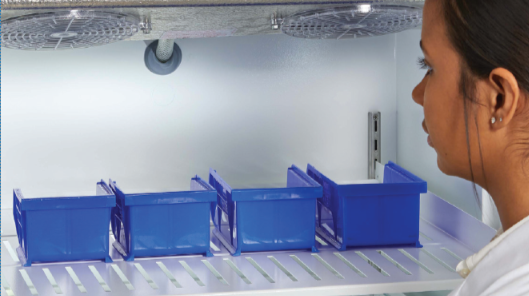Long before the COVID-19 pandemic, vaccine providers and program administrators faced significant challenges as they navigated the selection and purchase of effective vaccine storage equipment. Because vaccines require storage at specified temperature ranges, refrigerators and freezers play a significant role in the storage and handling process. Proper storage is critical to ensure the safety and viability of life-saving vaccines.
Data collected by the Advisory Committee on Immunization Practices (ACIP) and the National Institute of Standards and Technology (NIST) indicated that refrigerators and freezers used to store vaccines in clinics and hospitals were, and continue to be, a major risk point. The CDC Vaccine Storage and Handling Toolkit was initially launched in 2012 to provide guidelines and recommendations for vaccine handling and storage across the cold chain. The toolkit is updated periodically and provides guidance that improves the safety and efficiency of vaccine storage.
However, the toolkit does not provide clearly defined performance criteria for cold storage. Performance differences between purpose-built vaccine refrigerators may be significant but may be identified only through testing that simulates real-world use related to load conditions and door openings, as well as measuring cabinet temperature across all potential storage locations.
The NSF Joint Committee for Vaccine Storage was formed in 2015 to develop a new standard. The committee was responsible for creating a standard that ensures engineering controls are in place to assist in safely storing vaccines under real-world conditions in clinical environments. The NSF/ANSI 456 Vaccine Storage Standard was finalized in May 2021, and equipment manufacturers can submit their products for independent testing and certification against the standard.
We recently spoke with Dennis Smith, a member of the NSF Joint Committee for Vaccine Storage tasked with creating the new standard, to provide a manufacturer’s perspective on the implications of the new standard including the certification of vaccine storage units.
Dennis, please tell us about yourself and the role you played on the NSF Joint Committee.
I supported the committee providing perspective from the refrigerator/freezer manufacturers. My role was chair of the use group, and the committee’s responsibility was to look at developing the actual test methods that represented how the end users interact and use these units in the field. We needed to make sure that the test methods adequately challenged the performance of the refrigerator or freezer to simulate real-world field usage.
Why was this new NSF/ANSI 456 Vaccine Storage Standard needed?
Up until the release of the NSF/ANSI 456 Standard there wasn’t a good standard in North America that could be referenced for the performance of a refrigerator or freezer for the storage of vaccines or refrigerated medications. What was available, the CDC Storage and Handling Toolkit, provided guidance on how to store vaccines in refrigerators and freezers, but there were still issues in the field where providers were losing vaccines due to poor temperature performance. The providers were seeking something more that focused on performance and how these units were being used in real-world conditions. The committee was established to develop a standard that looked at overall performance of the refrigerators and freezers.
Who created the new NSF/ANSI 456 Vaccine Storage Standard, and what was the driving force?
The NSF/ANSI 456 Standard was developed by a committee including manufacturers of vaccines, directors from several state health departments, pediatricians and physicians, members from the Immunization Coalition, National Association of County and City Health Officials (NACCHO), National Institute of Standards and Technology (NIST), and the CDC, as well as multiple equipment manufacturers. It was a very cross-functional group.
The decisions on what requirements were needed in the standard were driven by public health members and end users. The key aspects of the requirements were driven by research and data collected from healthcare facilities throughout the U.S. Health clinics were visited, and usage data collected to understand how these units were being used. The test methods in the standard were developed to provide confidence that the vaccines would maintain their temperature requirements and stay in compliance during these real-world use cases.
Can you explain the basics of the standard?
The standard follows the standard format for an ANSI certified standard. The standard is written to address both refrigerators and freezers and covers design and construction, test methods, performance requirements, and guidance on performing the actual temperature measurements including construction of a vaccine simulation device. NIST provided a significant amount of support for the development of the test methodologies and how to perform the temperature measurements that were written into the standard. The standard itself includes some minimum refrigerator and freezer performance requirements throughout the testing protocols.
The test method portion of the standard is focused on maintaining temperature performance through frequent door openings and door openings related to loading of the cabinet, as well as how many vaccines are stored in the unit. We looked at two storage scenarios to develop the requirements, which were a totally empty cabinet and a totally full cabinet. We simulated the full cabinet by filling the units with standard size boxes to make sure we filled a large percentage of total volume inside. Many storage units are packed very full when they first receive their vaccine shipments, so we wanted to make sure that the performance of the unit was the same whether empty or full. In addition to testing the unit with two different storage scenarios the units are tested with multiple and frequent door openings in these storage scenarios. The refrigerators or freezers must maintain a temperature that is specific to the product that would be stored in that particular device during the duration of the test.
The door openings are a critical piece of the requirements. When we were out in the field, we observed two typical use cases. During the daytime there were many short openings when they were getting in and out of the refrigerator to pull vaccines for injection. The other use case was a very long door opening. This is when they’re refilling or restocking the refrigerator and we found that to average around three minutes.
So, the protocol was written to address both cases, a large number of short, sequential door openings and then a long door opening. These protocols are tested on both an empty and a full cabinet.
What were the major challenges/surprises that the committee faced?
I think there were two main challenges. First was to develop what we call a vaccine simulation device (VSD) which is a way to measure the performance of the actual unit. There was a significant amount of time spent to develop this device to make sure that it accurately represented a typical single-dose vaccine vial in a steady state temperature condition and in a dynamic temperature changing condition like a door opening.
Second was to address the layout of how the temperatures would be measured within the cabinet. There was a lot of work done to identify what the worst-case conditions would be in the field. Multiple VSDs were then used within the cabinet to map the temperature distribution during steady state and door openings. Additionally, we had to ensure that the measurement was scalable to all different cabinet sizes to reflect the different refrigerator and freezer units that are available. The test methods had to be able to work on any size equipment.
How is the new standard going to improve public health and safety?
The biggest benefit is that if a vaccine provider purchases a vaccine storage unit that is certified to the NSF standard, they will be confident in the performance of that unit, and that with normal usage, the vaccines will be stored safely within the temperature range specified by the manufacturers of the vaccines. Having an NSF certified unit should lead to less temperature excursions for the provider and improved vaccination effectiveness for the public.
Long term, we are hoping to see a higher rate of effective vaccinations across the U.S.
Did the COVID-19 pandemic have any impact on the committee’s efforts on this new standard?
The pandemic was additional confirmation that we needed a standard out there to support the storage of vaccines.
What are the implications of the new standard for vaccine refrigerator and freezer manufacturers?
The new standard will set a new, higher standard for the performance of purpose-built, medical-grade vaccine refrigerators and freezers. From the manufacturer standpoint, they’re going to have to review their portfolio and address or redesign products to be compliant with this standard.
What is next for the committee? Will the standard evolve or change over time?
The standard is considered a living standard. The committee continues to meet to work on continually improving the standard. Anyone can offer recommendations for changes or additions to present to the NSF committee.
Between the CDC Vaccine Storage and Handling Toolkit which makes important recommendation to help protect the safety and efficacy of vaccines, and the new NSF/ANSI 456 Vaccine Storage Standard which further defines appropriate temperature performance for vaccine storage equipment, significant progress has been made to improve the safety and viability of vaccines.
Ongoing efforts to further protect public health via safe and effective vaccine storage will continue to support effective immunization.





